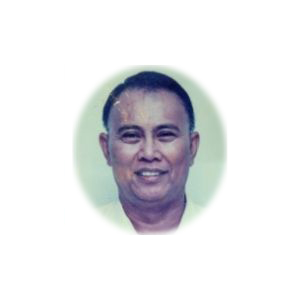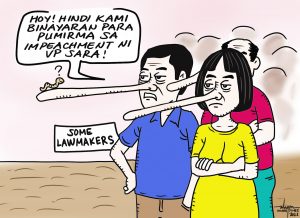WE READ with the most seriousness the second installment of what is expected from the still-to-be published book of our publisher lawyer Jesus “Jess” Dureza. The book already has its title “I Walked with Presidents.” And rightly so because publisher Jess is one of only very few Mindanaoans who was able to serve in various capacities with some four administrations in the country.
From the first two installments we already knew that working with Presidents, especially those whose passion is to genuinely serve the country and its people, is not just plain walking with the country’s chief executives. It is being with them through thick and thin; come hell or high water, and doing things exactly as the President wishes even if this would mean putting oneself on the way to crucifixion site.
“Walking” or working with Presidents could mean preparedness to sacrifice regular hours of sleep to ensure that he/she is at the chief executive’s call any time of the day.
We remember one time we were told by Publisher Jess that when he was still chief of the Office of the President in Mindanao during the time of President Ramos he was flying with the then President from Davao to Zamboanga City. Jess told us he was hoping he could get a little sleep while the chopper was on the air.
To his chagrin the President who was at his front seat asked from his aide stacks of documents and read them even as he was scribbling marginal notes and instructions. And Jess said every time the documents had something to do with Mindanao concerns Ramos passed it on him with notes on his expectation. With that, according to Jess, working, walking or flying with Presidents is “sleepless anywhere and everywhere.”
We have no idea whether Jess would include that particular experience with then President Ramos in his forthcoming book. But we are certain that what he shared with us is only one of many experiences he had while working with three other Presidents including his classmate and fellow Davaoeno Rodrigo R. Duterte.
Our resolve for now is to compile a copy of this newspaper in each issue that Publisher Jess’ narrative is published. At least, even if we will not be fortunate to get a copy of his book when it is finally published, we already have copies of manuscripts that contain what are written therein.
**************************
Starting tomorrow, October 15, 2020 the 10-hour curfew and the liquor ban will again be imposed in Davao City and is effective until December 31, of this year. The re-imposition is mandated under Executive Order No. 55 issued by Davao City Mayor Sara Duterte-Carpio.
What is really happening in Davao City as far as the prevalence of the Corona Virus Disease 2019 (CoViD 19) is concerned?
Many are asking this question because so far the city still remains under the Modified General Community Quarantine (MGCQ) category. Under that quarantine level several businesses are already opened, factories allowed to operate in the hope that the city’s economy will be re-jumpstarted.
Yes, it is common knowledge that since the city was hit by the CoViD pandemic the economy was not just put on a stand-still but it regressed at its fastest pace. Davaoenos have to make do with whatever innovative way of earning money to sustain their needs trying to survive the worst of crisis to hit the entire world, Davao included of course.
The city’s residents know that there is hardly anything to expect from the local government to meet their daily need, especially the close to 60 to 70 percent of the city’s population that belong to the marginalized sector.
That was why, there was common observation that when the city was put at MGCQ quarantine category and the economy was re-opened rather slowly and carefully, there was calculated jubilation among the people.
And we have noted that business owners did not grudge government when they were mandated to make renovations in their establishments in order to conform to the minimum health standard protocols. They invested what perhaps was left of their savings to introduce the required renovations and preventive measures so customers will be safe. With the renovations and added set-ups they hope their shops will not become the convergence of the deadly virus and the sources of infection.
Unfortunately for Davao’s economy, in only a few days after the city was down-graded to MGCQ category the leadership decided to re-impose the lengthened curfew hours and the liquor ban as well. And according to EO 55 the decision to issue EO 55 was based on the result of interviews on those who were found positive of the virus. The CoViD 19 victims’ responses, asserts the EO, indicate that they got the virus from their having engaged in certain “non-essential activities.”
EO No. 55 also adds that the only hospital catering to CoViD 19 patients, the Southern Philippines Medical Center (SPMC), is now in full occupancy so there is urgent need to regulate activities that are seen contributing to the spread of the virus.
On another vein, there is this part of the order that says it is needed to help the police in their anti-criminality efforts since some of its personnel are in quarantine due to infection of the virus.
Somehow, we find the need for the city leadership to re-examine the basis of the decision to re-impose the curfew as well as the liquor ban. How does that work with the desire to reopen the economy and the intention to curb criminality in the city this time of the pandemic?
An accounting of the total number of CoViD infected individuals in the city indicates that it is barely 0.14 percent of the city’s total population of about 1.6 million people. And the figure of those who died are even much lower. In other words, the present methods of intervention adopted by the city – preventive and curative – can be assumed as effective.
That is why we cannot blame if some people would think that the present health crisis is not really a pandemic but a “plan-demic.” Why because it appears that all cases brought to the hospital that partake of one, two or three known symptoms of the virus become CoViD 19 cases. And these are religiously included in the reportorial process adopted by health authorities. After all, it is more convenient that way than going through delicately sifting indicators to establish the real cause of death of patients.
We reiterate that we are not against the issuance of the EO. However, we are hard-put reconciling how it would allow the economy of the city to slowly regain grounds when the mandate under the EO cuts substantially what the economy has started recovering.
And, will it help the police curb criminality at this worst time of the city? We doubt. We even believe that the restrictions under the EO would force even those with no criminal minds to commit a crime. Should we be oblivious of the saying that when the worst of time comes, some resort, though hesitantly, to do the proverbial “kapit sa patalim.” All because of the need to survive from hunger.
Maybe the city has to adopt another approach, one that would instill in the people’s mind the need to change their behavior and make discipline an integral part of their system, not because they are ordered to. This way the government would probably succeed in shifting the burden of preventing the spread of the virus to the people themselves with the former only providing the necessary parameters.


